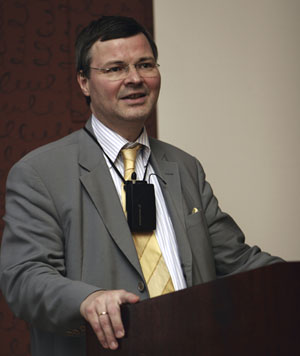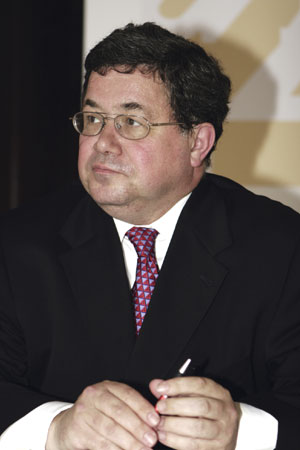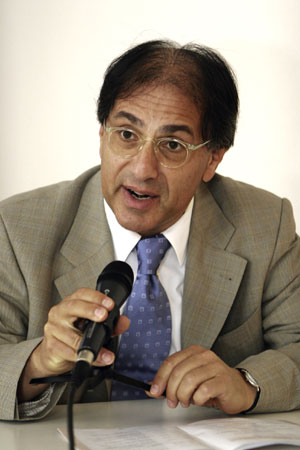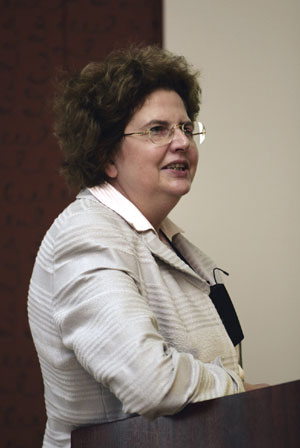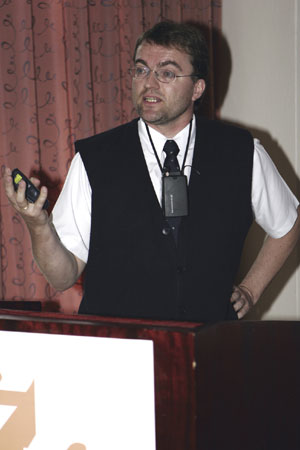

GD — Society for Dermopharmacy
 |
Special Issue
Issue 2 (2005) |
Dermatotherapy
Interdisciplinary
progress for the benefit of skin
Trends in dermatotherapy
The level of insights regarding the therapy of frequent skin diseases
was summarized in the course of the scientific symposium "Interdisciplinary
Progress for the Benefit of Skin" organized by the Gesellschaft für
Dermopharmazie on the occasion of its ten-year anniversary in Mönchengladbach
on 2nd July 2005. This synopsis disclosed the differentiated and manifold
treatment methods for mycosis pedis, light skin cancer, neurodermatitis,
psoriasis and chronical wounds and informed at the same time about many
unsolved questions which are still to be responded in research.
The diversity of the subjects dealt with is representative for the versatile measures by the GD to improve the situation of persons suffering from skin diseases, the acting GD president professor Dr. Hans Christian Korting, Munich explained. He recognized the GD as interdisciplinary platform whose work is focused on sustainability and which is prepared for the challenges emerging in the future.
Mutual efforts to combat
mycosis pedis and nail mycosis
Korting opened the program with a lecture on the subject "Interdisciplinary Management in the Treatment of Mycosis Pedis and Nail Mycosis". The tinea pedis ranks among the most frequent manifest infection diseases of men. Approximately 30 percent of all adults in Europe are afflicted by the disease. Although there have been effective and practicable therapy options for years, the affection rate is largely stable. Owing to this unusual challenge, an interdisciplinary therapy management is called for.
In view of the large number of afflicted persons and the unpretentious and safe treatment possibility for the particularly frequent interdigital type of the Tinea pedis, the first application of a topical antimycotic based on self-diagnosis by the patient and a consultation in the pharmacy without medical specialist is to be considered. In case this first therapy trial remains unsuccessful, the medical specialist is needed.
|
|
| The acting GD-president professor Dr. Hans Christian Korting, Munich, introduced the GD concept regarding the interdisciplinary management of Tinea pedis. Accordingly, a self-medication as first treatment measure for the particularly wide-spread interdigital type of the Tinea pedis is also to be considered based on a swiftly effective topical antimycotic after consultation in the pharmacy. In case a therapy trial of the type is not effective, the pharmacy is to refer the patient to a dermatologist. |
A recommendation of the GD in this respect in the course of a statement published in 2004 did not meet with acceptance by everyone. However it is to be taken into account that nearly all topical antimycotics are no longer reimbursable since January 2004 and pharmacies have become the first contact point for many persons concerned.
Pharmacies are entrusted with the task to draw the patient's attention to the necessity of treatment. If no disorders are complained about, a treatment is still required because Mycosis pedis may prepare the ground for severe after-effects. Thus for example it can be the entrance for the causative organisms of the lower leg erysipel as could be shown in a case-control study.
The once-a-day application of a one-percent Terbinafin cream over the period of one week has proven as beneficial therapy of the Tinea pedis interdigitalis. It is superior to a four-week application of a Clotrimazol cream both mycologically and clinically. However, so far this is not reflected by the prescription and application figures.
The systemical Terbinafin is the product of choice at onychomycosis whereas the relapse rate decreases with ongoing therapy duration. The relevance of the therapy duration for the long-term therapy success could be shown with Fluconazol for the first time. There is information available regarding a synergistic effect for the additional topical application of Amorolfin lacquer at Mycosis pedis.
Novel antimycotics for the regular application at Mycosis pedis and nail mycosis are for the time being not expected according to Korting. The new active agent candidates are at present not even in the clinical development so that at present available substances have to suffice for a longer period of time.
Though, molecular rapid diagnostics could be available in brief as innovation providing a result after approximately two days whereas results are available at present after 30 days. For new diagnostics of the type also samples via pharmacies could possibly be taken in the future.
Therapy and prophylaxis
of light skin cancer
Professor Dr. Hans F. Merk, Aachen, presented therapeutical and prophylactic approach against light skin cancer. He emphasized the significance of actinic keratosis which may pass into a malignant state. At some patients it appears in enormous quantities over large skin areas in particular after strong UV exposition or after organ transplantations.
|
|
| Professor Dr. Hans F. Merk, Aachen, moderated conjointly the lectures focusing on dermatotherapy with his colleague professor Dr. Dr. Thomas Ruzicka, Düsseldorf. He held an own lecture regarding current trends in the field of therapy and prophylaxis of light skin cancer. Promising new active agent candidates for the therapy and secondary prevention of actinic keratoses are inhibitors of Cyclooxygenase-2 which interferes in the essential processes of cancerogenese and is additionally activated by UV light. |
Accordingly, light skin cancer is the most frequent cause of death after nephritic and heart transplantations as these patients are subject to particularly severe immune suppression. Mostly, light skin cancer is induced by UVB radiation and develops via preliminary stages for years. Sun protection not only has a prophylactic effect but may also reduce existing actinic keratoses.
The photodynamic therapy based on 5-Aminolävulinacid is particularly suited for the treatment in case of large area infestations. The oldest form of the medicamentous therapy in case of light skin cancer is the topically applied 5-Fluorouracil (5-FU). This medicinal agent is deactivated by a polymorph enzyme and therefore only metabolized to a minor extent by about five percent of the population.
This is regarded for the systemical therapy, however a case of toxical Agranulocytosis after application of 5-FU in the head area shows that the polymorphism may also be relevant for the topical application. A large number of unreported cases of damaged patients is to be feared at which the context is not identified.
In the USA - in contrast to Germany - the Imiquimod cream is also authorized for the treatment of actinic keratoses. Imiquimod takes effect via the modification of cytokine expression which is mediated by the toll-like-7-receptor and entails healing rates of 40 to 50 percent.
Inhibitors of the Cyclooxygenase-2 (COX-2) represent a further approach for the therapy and moreover potentially in particular for the secondary prevention. OX-2 enhances the vascularization and cell proliferation thus reducing apoptosis. Consequently it fosters essential processes of cancerogenesis and is furthermore activated by UV light. It could be shown in mice that high COX-2-concentrations favour the formation of tumours after a suited initiation and COX-2-inhibitors may offer additional protection to counter this formation.
Hence, there is a multitude of non-invasive therapy options against actinic keratoses and other types of light skin cancer available. This gives rise to hope that there will also be non-invasive concepts available in the near future for the diagnostics of these tumours. For this aim for example sonography, confocal laser microscropy and the optical coherence tomography with high-resolution apparatus are applicable as they had been developed in Aachen. They allow a differentiation of skin layers and promise to allow for a distinction between malignous and benign cells.
New insights concerning
atopical eczema
Prof. Dr. Dr. Thomas Ruzicka, Düsseldorf, described contemporaneous strategies for the treatment of the atopical eczema. He considers the high incidence and wide spreading with children as essential cause for the major public interest in this disease. Thus, 10 to 20 percent of children and one to two percent of adults are affected whereas the prevalence doubles every ten years. The disease entails considerable losses of quality of life which concerns also the parents and the remaining family at diseased children.
|
|
| The GD secretary professor Dr. Dr. Thomas Ruzicka, Düsseldorf acted as moderator and referee relating to the subject "Current Strategies for the Treatment of Atopical Eczema". He emphasized that some "dogmas" spread for a long time could not be proven in recent studies. Thus breast feeding does not protect infants from eczema attacks and the keeping of animals does not represent a provocation factor for the atopical eczema. |
Although the diagnosis is in most cases relatively easily established, some more rare diseases may first of all entail a similar clinical picture - a fact that is to be considered in diagnosing. The complex pathophysiology of the disease starts from an innate sensitivity. Owing to exterior trigger factors, the disease breaks out. Similar to asthma, an extrinsic and intrinsic type is distinguished. The latter concerns about 20 percent of patients at which no increased IgE is the case.
As medicamentous therapy, glucocorticoids were introduced in the fifties. In the seventies, phototherapy and ciclosporine added. Meanwhile, the topical immune modulators Tacrolimus and Pimecrolimus are introduced as alternatives for the established but often unpopular therapy with glucocorticoids.
When applying topical immuno-modulators, skin atrophy known from glucocorticoids is omitted. As unwanted effect of this new substance class skin irritation is observed at the most in short-term, this in particular with adult users. According to Ruzicka's opinion, the recent discussion about a possibly increased risk for the development of skin tumours and lymphoma is not justified in view of the very short duration of therapy for the most part and the minimal blood level after topical application.
Apart from medicaments also psychological aspects should be implied in therapy. Some of the "dogmas" regarding neurodermatitis which have been wide-spread for a long period of time could however not been confirmed in recent investigations. For example breast-feeding does not protect from neurodermatitis, is nevertheless still recommended. In contrast, the keeping of haired animals does not provoke atopical eczema, cats even prevent from eczema attacks.
Moreover, the assertion that the undergoing of numerous infections ensures protection from atopical eczema is not proven. This assessment could originate from a reduced publication of studies with reversed results. The evaluation of hypo-sensitization is in contrast still unclear.
Numerous patients are interested in an "alternative" therapy, but it has to be warned against undefined compounds not only because of their questionable effect but especially because of possible contact allergies or systemical toxicity for example by heavy metals. For the future, therapies based on chemo-kinantagonists and prevention based on probiotics represent promising approach against neurodermatitis.
Innovative dermatics
countering psoriasis
Professor Dr. Monika Schäfer-Korting, Berlin, presented an overview about innovative drugs for the therapy of psoriasis. The disease is genetically determined and manifests in dependence of individual triggering factors. Affected are roughly 1.5 percent of the population whereas about one quarter of the patients suffers from severe forms of the disease.
|
|
|
The pharmacologist professor Dr. Monika Schäfer-Korting, Berlin, who is member of the GD management lectured about innovative dermatics relating to the therapy of psoriasis. Latest research activities aim at substances promising long-term success or even a healing of the disease. She mentioned the sphingolipids as auspicious novel active agent group for topical application which she analyzed in her working group countering the partition of keratinocytes and interacting with different signal transduction pathways relevant for the pathogenesis of psoriasis. |
Since the affection is marked by a relatively typical cytokine expression pattern, different targets for current drugs are appropriate. At psoriasis patients a reduced concentration of soluble TNF-alpha can often be noticed. As first Biological countering psoriasis, Etanercept has therefore been applied representing a fusion protein from soluble TNF-alpha.
In the therapy with Etanercept, increased infections by reduced immune response are impending as major side effect whereas in particular the reactivation of tuberculosis is to be feared. As Etanercept possesses structure components of non-human origin, patients may form anti-bodies against the drug, neutralizing it and impairing its effect.
This problem is omitted to a large extent for humanized anti-bodies as Efalizumab at which only the linking region of the anti-body is formed by the mouse. Efalizumab links to the alpha-subunit of CD11a. Reports about numerous unwanted effects are on hand which however only appear after the first injection. As the success only holds up to six weeks after the treatment, it should optimally be performed as permanent therapy which however creates considerable costs in comparison to other therapy options.
Latest research does not target at permanent treatment but rather at long-term success or even healing of psoriasis. For this aim sphingolipids are for example analyzed since sphingosin-1-phosphate counters the fission of keratinocytes and interacts with various signalling pathways that seem to be of relevance for the pathogenesis of psoriasis for example with the TGF-alpha-signalling pathway. In order to guide sphingosin-1-phosphate through the skin at topical application, lipid-based systems are suited at which the active agent is contained in liquid oil droplets.
Innovation and evidence
in wound treatment
Professor Dr. Matthias Augustin, Hamburg, dealt in his lecture regarding innovation and evidence in the therapy of chronical wounds both with the basic relationship between innovation and evidence and treatment options for chronical wounds. For about 40 percent of the standard measures in wound practice there is evidence on level IV in the sense of evidence-based medicine. However, there is only scarce evidence based on studies especially in wound therapy but also in numerous other indications for many in practice important and established measures.
|
|
| The head of the GD department Dermatotherapy, professor Dr. Matthias Augustin, Hamburg, looked into the fundamental subject of the relationship between innovation and evidence exemplary based on wound therapy. He complained that the concept of evidence-based medicine - in principle reasonable - is increasingly misused as control instrument thus retarding the introduction of innovative therapy procedures. In particular, there are numerous novel methods in the field of wound treatment which are effective but not recognized as being evidence-based. |
The usual handling of the evidence concept should be looked upon critically according to the opinion of Augustin. As the establishing of evidence is time-consuming there is the more evidence the less innovative a therapy is. Therefore, the objective is to find a compromise between antagonistic targets of evidence and innovation and to determine the optimal point in time for the introduction of an innovative therapy in practice.
Unfortunately, an ongoing increasing tendency towards more evidence to the debit of innovation can be observed in Germany. Evidence-based medicine is exploited by many involved parties and employed as control instrument. In contrast, it is not understood in politics which major significance other methods may have for which there is no evidence from comprehensive studies available. This applies in particular if it concerns therapies against infrequent diseases.
Augustin describes the therapy of chronical wounds as puzzle work. There is no generally binding way of proceedings but for each patient individual solutions are selected from a variety of treatment options. Accordingly, qualified diagnostics of wounds are important at which manifold forms and causes are to be distinguished. The treatment options can be classified in measures of local therapy, systemical therapies, operations as well as physical and other therapies.
Essential for the therapy success is the wound cleansing which may be performed by means of drinking water and sterile compresses. Although, the superiority of the humid wound healing is proven, only half of all chronical wounds are treated this way in Germany. For wound healing a balance between build-up and decomposition of the tissue is required whereas in different healing phases different growth factors are vital.
The therapy should establish the context between growth factors instead of substituting individual factors. Proteases could prove as promising auxiliaries for the local therapy in the future. This applies for example to krillasis from the digestive tract of the krill which can be applied for the cleansing of Ulcera and will probably be available next year.
Particularly versatile are the alternatives in the systemical treatment to which a qualified pain therapy at painful wounds equally belongs in the end. For the employment of systemical antibiotics in wound healing there is however only scarce evidence. Oral zinc is only beneficial at low zinc level. The selection of suited operations has to be effected individually.
Augustin mentioned the transplantation of autologous keratinocytes as example for a novel method. Among physical measures, the compression with a short-streak bandage is regarded as standard treatment for the Ulcus cruris. Complementary, the apparative intermitting compression and the so far only stationarily applied vacuum therapy come into question which had already been filed for evaluation to the Gemeinsame Bundesausschuss (Mutual Federal Committee) in the year 2000. It is the best example for an innovative therapy which is recognized as being effective on the one hand but not yet as evidence-based on the other hand. tmb
top
